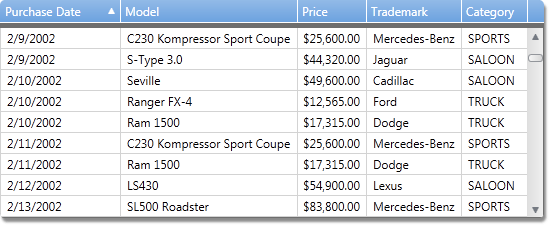Information Presentation Basics
- 3 minutes to read
Pivot Grid is designed to convert lengthy table data into compact reports that display summarized data, and can easily be customized by end-users to achieve the desired layout. These compact reports bring you the functionality of Pivot Tables that are available in such applications as Microsoft Access or Microsoft Excel.
What Kind of Data is Used as the Source for DXPivotGrid
To see how DXPivotGrid converts raw table data into a flexible report, imagine a car sales database with the following structure:

The main data we are interested in is contained in the Orders table. Each record in this table is a single-car purchase.
Data tables, like the Orders table, are often referred to as Fact Tables. This is because such tables contain the facts that took place, and will be analyzed. The remaining tables are needed to obtain human-readable information. In our example, they are needed to get the car model name or car category using the car id stored within the fact table. They wouldn’t be needed if a user could identify cars by their IDs. These additional tables are usually called Dimension Tables.
To get human-readable information about car sales, we can merge data from all the tables into a single query. And this is how this data would look if displayed by DXGrid or another grid control:

The number of records in such a query will match the number of records in the fact table. In our example, the number of records will match the number of car orders. If we need to analyze car sales over a long period, say several years, we can get numerous records which are almost impossible to analyze using traditional grid controls.
If you wish to see how sales have changed over time, you will most probably be interested in changes that took place from month to month or even from year to year. Another data analysis alternative is to see which car model has the most sales. In either case, you would like to compare summaries calculated against groups of related records. You can obtain such values even when using traditional grid controls, but with DXPivotGrid less effort is needed, and the resulting reports are much more compact and easier to analyze.
DXPivotGrid Compared to Traditional Grid Controls
As with other data-aware controls, DXPivotGrid requires you to create a number of fields - objects bound to real data source fields. The fields whose data you need to analyze should be placed in the data area. Then place some fields in the row and column area.
The image below shows you how raw table data is transformed into a compact report that allows data to be easily analyzed.
